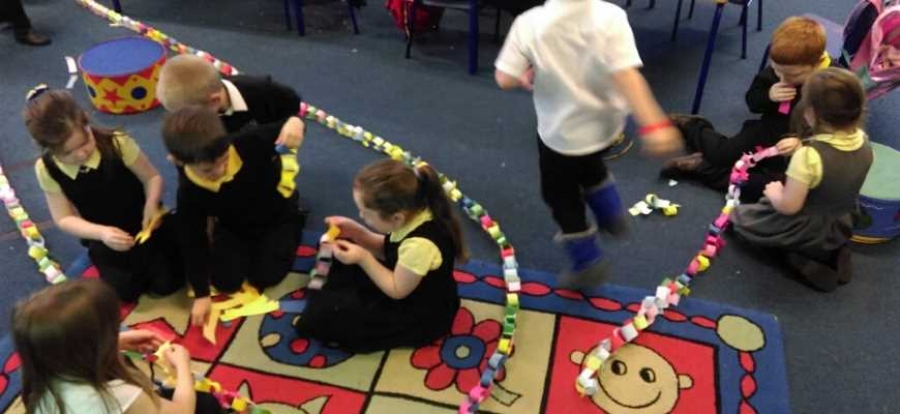Activities can be open to interpretation and children are given the opportunity to get creative with their own learning process! Learning is the right of every individual and under the right circumstances and creating the right environment, everyone can learn!

2. It gives children an opportunity to consolidate and build upon skills previously learned and also to apply these skills within different contexts.
Active learning not only allows children to use this time to consolidate their learning, but also develop these skills within a cross-curricular environment. One example would be linking a topic theme with a numeracy or literacy focus - we used the ‘People Who Help Us’ topic to do exactly this. The topic was taught through a Storyline approach and gave room to active opportunities of skill-based learning; learning that was encouraged to flow throughout the curriculum. Investigating money, which was covered during a Maths session, was interwoven into role play experiences.

3. It enables the teacher to engage with responsive planning and provide immediate, effective feedback.
In our Primary 1 classroom, we use ‘Freeplay Friday’ as a tool to inform us of progress, areas of difficulty and those who need extension. ‘Freeplay Friday’ was coined when we noticed that the size of our class, and the various groups within it, made it a little tricky to keep track of all the progress in literacy and numeracy. This is an opportunity for the children to engage in different activities which relate to learning covered during the past week.
The activities are exciting, informative and are also created at an appropriate level, which allows the children to work independently and at their own speed. We ensure tasks are suitably differentiated through self-choice and expectation. Those who wish to be challenged are and those who want to play it safe, do. This develops the confidence of the children in applying their developed skills. We, as professionals can observe the children closely and then, in turn responsively plan their next steps and give immediate feedback.
4. It involves learners in their own unique experience of learning.
The children are in charge. They develop a sense of pride in the fact that they choose their own activity or they can work on their own productively without any assistance. Using skills which they have learned previously, they can apply this into different contexts. The use of more vague tasks often lead to an expression of each individual and the more organised, structured tasks allow the children to focus on specific skills or learning intentions.

5. Children are at the heart of active learning.
We want them to learn. This has to be done in a fun way or they won’t remember the experience. We often remember our times at school, either through negative moments where we got something wrong or found something really hard, or we remember things because we enjoyed them and they were slightly out of the ordinary for us.
6. It allows children to access their learning at different levels.
Children, on any level of learning, are given the opportunity to become involved in Active Learning. The Interactive Whiteboard is a particularly effective tool in lessons (ask any teacher!). Literacy, numeracy, health and wellbeing games, handwriting practise and interactive resources provide beneficial learning experiences, and we know this as children enjoy using technology. Tasks can be set at appropriate paces, and there is an avoidance of types of lessons which do not suit certain types of learners and show no real emphasis on the progress and journey of the learner. It begins to bridge the gap between levels of learning; higher ability children are able to access the role of facilitator, allowing children to become part of each other’s learning experience.

7. It builds talking, listening and problem solving skills.
We are trying to create a less passive classroom and encourage thought, self-assessment and the answer that might just be wrong (but you tried anyway!). Active Learning creates an environment which encourages cooperative and collaborative work. The engagement of classmates is a fascinating and pleasurable thing to see indeed: as a teacher, there is nothing more satisfying that seeing children use their communication skills to develop their understanding and critical-thinking skills. Whether it’s deciding what materials are absorbent or waterproof, or even simply discussing what they predict will happen next in their new reading book, children have the opportunity to share, reflect, reason and draw conclusion from Active Learning.

8. Promotes awareness of the world the children live in and how they can apply skills into a real situation.
Children are made aware of learning and how it will eventually affect them in the future. How can I use my coin counting in the world outside my classroom? Eventually children will make the connection between the two and will adapt it in context. Active learning through purposeful play or choice, often allows children to experience something they may have not before. This can be built through most subjects, however I have found my best results come from interdisciplinary learning, where children are taught via cross curricular methods.
For example, in People Who Help, children are involved in aspects of real work life for example dramatisations of emergency situations, inviting guest speakers from the emergency services to come in and chat with the class. Class mascots prove to be an excellent resource in promoting real life skills; we use Etienne and Jorge, our multilingual animals, to promote building positive relationships. Children are chosen at random every Friday and are given the mascot to take home. At home the children are encouraged to include Etienne and Jorge in their daily routines, encouraging them to go on adventures, engage in conversation with family members and even help with cooking or even better… homework!

9. Increases motivation in the children (and the teachers too!).
In using Active Learning strategies, we can also build a stronger classroom community, one which encourages the art of conversation and, in doing so, builds lasting relationships. The opportunity to work in cooperative learning teams to solve problems, or getting involved in Think, Pair, Share activities allows children to focus primarily on conversing and using key vocabulary with their peers. It allows us teachers to roll our sleeves up and get involved with the discussions, to sit on the carpet and get to the bottom of why John thinks that sponge is absorbent or waterproof.
10. Active learning equals active mind.
Children are encouraged to be inquisitive in their own learning experience. To question why they learn what they learn. Asking ‘why do I need to learn and adapt this skill for my future and what is its importance in my role in society?’ In short, an active mind equals a very happy teacher!
Do you use Active Learning in your classroom? Share your thoughts below.


















